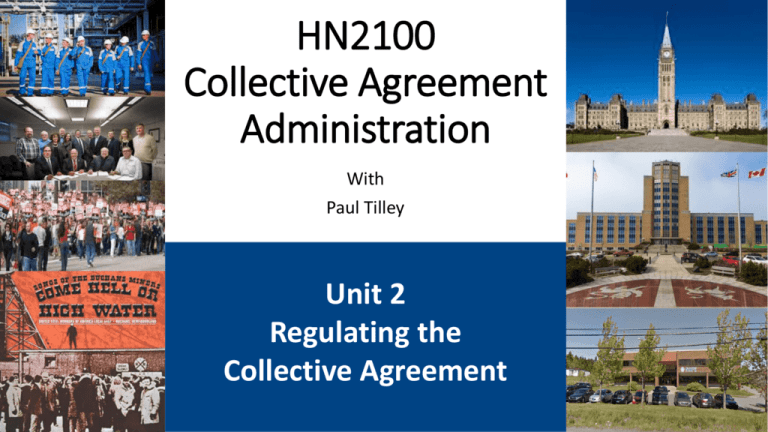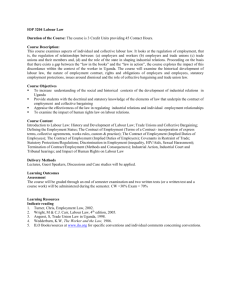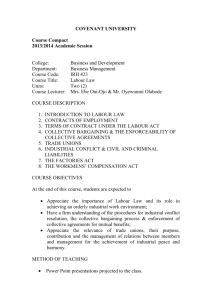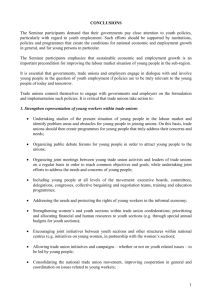Unions in Canada - Paul Tilley's Resource Wiki
advertisement

HN2100 Collective Agreement Administration With Paul Tilley Unit 2 Regulating the Collective Agreement Unit 1 Unit 2: Regulating the Collective Agreement • After completing this unit, you should be able to: 1. 2. 3. 4. 5. 6. 7. 8. 9. 10. 11. Discuss the History of Labour Relations In Canada Describe what a union is and explain why employees join unions. Discuss union membership in the world and in Canada. Discuss the development of unions in Canada Describe the process of forming a union in Canada Explain how to determine an appropriate bargaining unit. Describe the process of developing a Collective Agreement Describe the duty to bargain in good faith. Identify unfair labour practices by employers during negotiation. Explain statutory freeze. Explain the legal requirements established under Canadian collective bargaining law concerning collective agreements. 12. Describe how collective agreements define the relationship between the trade union and the employee. 13. Explain the roles of the federal and provincial governments in labour relations. Overview of Unit 2 • This unit looks extensively at the legal requirements that govern the bargaining process for collective bargaining in Canada. These requirements, although not identical across the different jurisdictions, form the framework of collective agreement administration. The legal effect of a collective agreement helps to establish a special relationship between the trade union and the employee. This "special relationship circumvents "individual" rights and replaces them with "collective" rights. The Right to unionize United Nations: Universal Declaration of Human Rights • Article 23 (4): Everyone has the right to form and to join trade unions for the protection of his [or her] interests. http://www.un.org/en/documents/udhr/ Canada’s Industrial Relations Regulations 1. Right to join a trade union 2. Canada Labour Relations Board (certification procedures) 3. Acquisition or termination of bargaining rights 4. Bargaining and Agreement rules 5. Conciliation officer appointment 6. Conditions for legal strike or lockout 7. Methods to promote peace The Right to unionize in Canada Federal and Provincial Legislation Canada Labour Code • Employee freedoms • 8 (1) Every employee is free to join the trade union of their choice and to participate in its lawful activities. • Employer freedoms • (2) Every employer is free to join the employers’ organization of their choice and to participate in its lawful activities. http://laws-lois.justice.gc.ca/eng/acts/l-2/page-2.html#h-7 NL Labour Relations Act • Rights of employees and employers • 5. (1) An employee has the right to be a member of a trade union and to participate in its activities. (2) An employer has the right to be a member of an employers' organization and to participate in its activities. http://assembly.nl.ca/Legislation/sr/statutes/l01.htm The Canada Labour Code • Contains Labour legislation for firms operating under parliamentary authority (federal jurisdiction according to the Constitution Act) • • • • • • • fair employment practices wages and work hours vacations and holidays maternity benefits and sick leave employee safety job and income security industrial relations regulations Provincial Labour Regulations • Labour legislation for firms operating under provincial authority • Similar to Canada Labour Code • Laws vary across provinces • Laws are frequently revised • Administering labour relations is complex and time-consuming • NL Labour Relations Act • NL Labour Standards Act • NL Human Rights Act Unions in Canada • A Union is a formal association of workers that promotes the interests of its members through collective action. • Unions exist for three major reasons: • Economic: To promote economic gains for their members. Unions strive to improve the efficiency and equity of the ‘free market’ by providing a greater balance of bargaining power between individual workers and the firms they work for. They effectively redistribute the wealth through collective action that addresses the power imbalance between individuals and larger firms. • Political: To make political gains by promoting industrial democracy. Like economic motives, political motives attempt to lever the power of workers by working together as a single stronger voice for change. Unions lobby government and industry to seek benefits for their workers. • Human Rights: Unions work to establish standards for human rights in the workplace. Unions in Canada • Modern Unions: • Tend to focus on “Bread-and-butter” economic issues—wages, benefits, job security, and working conditions. • Are organized by kind of job and employer. • Seek multi-year collective agreements on economic issues as “contracts.” • Unions today emphasize • job security • gaining or maintaining benefits • Unions must co-operate with employers to ensure survival of unions and companies • Perhaps unionism will increase to help young people avoid being stuck in lowwage jobs Rise of Institutionalized Collective Bargaining in the Private Sector 1944 Privy Council Order PC 1003: • established a process to allow workers to certify a union, • once a union was certified the employer was obligated to recognize the union, • it also established grievance-arbitration procedures which involves a mechanism for the resolution of grievances without resort to strike action; • banned strikes during the life of a collective agreement, banning sympathy or solidarity strikes Rise of Institutionalized Collective Bargaining in the Public Sector • Late 60s also saw the beginning of the unionization of the public sector. • Provincial: Quebec grants collective bargaining rights to public sector workers, 1965. Remaining provinces do likewise from 1968-1978. • Federal: Public Service Staff Relations Act, 1967 • Restrictions on issues that can be negotiated - “Excluded are all matters respecting the organization of the public service, the assignment of duties, the classification of positions, and job evaluation” (Johnson, 2011: 369). • “estimated that public sector union membership increased from approximately 183,000 members in 1961 to 1.5 million members in 1981” (Rose, 2007: 185). Why Workers Join a Union • If employees believe they do not get what they need from their employer, they often turn to unions in hopes of achieving some sort of equitable treatment. • Workers tend to unionize for two key reasons: • They are dissatisfied with how they are treated by their employers. • They believe that unions can improve their work situations. The Development of Canadian Labour Unions • The Canadian labour movement really has made a lot of gains towards improving the cause of workers in the last century and a half. Minimum wages, overtime pay, workplace safety standards, maternity and parental leave, vacation pay, and protection from discrimination and harassment all largely resulted from initiatives brought about through the union movement. • 1873: national labour organization formed - “Canadian Labour Union” • 1886: Canadian Trades and Labour Congress (TLC) • 1908: Canadian Federation of Labour (CFL) • 1940: Canadian Congress of Labour (CCL) • 1944 Privy Council Order PC 1003: • established a process to allow workers to certify a union, • once a union was certified the employer was obligated to recognize the union, • it also established grievance-arbitration procedures which involves a mechanism for the resolution of grievances without resort to strike action; • banned strikes during the life of a collective agreement, banning sympathy or solidarity strikes • 1956: Canadian Labour Congress (CLC) • 1967: Public Sector Staff Relations Act • 1982: Charter of Rights and Freedoms • 1985: United Auto Workers of Canada (UAWC) Union Membership in Newfoundland and and Labrador Union Membership in Canada and the US Union Membership in the Developed World (2011) http://snohomishobserver.com/2011/05/ Trends in Union Membership on Canada • Unions are experiencing difficulties in attracting new members • Union membership as a percentage of the total workforce is declining (less than one-third) • Diversity in the workforce consists of non-traditional members of a union • More women, ethnic minorities • Employers are engaging in more anti-union activities, including more employee-friendly workplaces The Process of Forming a Union in Canada Jurisdiction Matters The specific legal process to have your union legally recognized, or "certified", depends on where your workplace is located. Labour law for most workplaces is covered by provincial legislation, so the specific legal steps to form a union will depend mainly on your province. Federal Jurisdiction While most workplaces will fall under provincial labour law, some workplaces are covered by federal labour law. These include workplaces in the Yukon, Northwest Territories, Nunavut and in the following industries: • • • • • • • • • broadcasting telecommunications banking air transportation shipping and navigation interprovincial or international transportation of goods or passengers uranium mining and processing grain handling federal crown corporations Stage 1 – Organizing Usually employee dissatisfaction creates an environment to begin a secret drive to organize Option 1 – A national union approaches the workers Option 2 – The workers approach the union IN SECRET – Initially, employees express their support for the union by signing union membership (Authorization) cards. A movement takes hold to get a majority of workers to sign a union card and pay a nominal fee. Stage 2 – Cards to Labour Board When the campaign has reached the proper level of support, these cards are then submitted to the appropriate provincial or federal labour relations board (Labour Board), along with what is often called the union's "application for certification." The Labour Board will keep the membership cards confidential and will not tell the employer who has signed or not signed a union membership card. Labour Board Defines Bargaining Unit • Supervisors and Bargaining Units • Supervisors are excluded from bargaining units • Defined as any individual with the authority to hire, transfer, discharge, discipline, and who uses independent judgment with employees • The Appropriate Bargaining Unit is determined by: • “Community of Interest” • Wages, hours, and working conditions • Traditional industry groupings for bargaining purposes • Physical location and amount of interaction and working relationships among employee groups • Supervision by similar levels of management Stage 3 – Labour Board Approval/Election The appropriate Labour Board can either certify (legally recognize) the union based on a check and count of the membership cards or; In Newfoundland and Labrador, if more than 65% of employees have signed cards, the Labour Relations Board will certify the union without holding a vote. When at least 40% but less than 65% of employees sign union cards, the Labour Relations Board will hold a certification vote (Representation Election) , generally within 5 working days. See: Newfoundland and Labrador Labour Relations Board Information Bulletin on Application for Certification See: Canada Industrial Relations Board Information Circular - Applications for Certifications Stage 4 – Labour Board Certification For workplaces in industries covered by Federal labour law and for workplaces in the Northwest Territories, Yukon and Nunavut, if more than 50% of employees have signed cards, the union can be certified. If 35% - 50% of employees have signed union cards, the Labour Board can hold a vote. Once your union has been officially certified by the Labour Board, you can begin to negotiate your first contract (also known as your collective agreement) as members of the union. PROVINCIAL JURISDICTION See: Newfoundland and Labrador Labour Relations Board Information Bulletin on Application for Certification FEDERAL JUSRISTICTION See: Canada Industrial Relations Board Information Circular - Applications for Certifications Stage 5 – In-House Election The newly certified union represents the workers in a “Union Local” The Local holds an Election amongst its members The elected executive represents the Local’s interests and conducts Bargaining on the member’s behalf. Stage 6 – Bargaining / Labour Action / Agreement After a union has been certified, employers have to meet with them and engage in what is called “good faith bargaining” This bargaining ideally culminates in a contract – an agreement between the union and the employers. The contract is then voted on by union members. If no contract is bargained, then the union can go on strike to put pressure on the employer. During the strike an employer can hire replacements – which unions called “scabs” to work instead of the striking workers. Employers are not allowed to fire workers while on strike, but they also are not prevented from replacing them with permanent replacements. One of the conditions of settlement of successful strikes is nearly always getting rid of the replacement workers. Legal Do’s and Don’ts for Managers During Unionization Employer Do’s Employer Don’ts • Discharge, suspend, transfer, layoff or otherwise discipline an employee for proper cause • Engage in threats, coercion or intimidation • Make a change in the operation that is reasonably necessary for the proper conduct of business • Hire spies or infiltrators to acquire information or influence union activities • Express management views on any matter providing it does not use intimidation or coercion • Interrogate employee about their voting intentions • Promise or alter the terms of employment in response to a union drive • Shut down any establishment to avoid or eliminate a union • And many other activities… Developing a Collective Agreement • Collective Bargaining is a multistage process through which union leaders and management personnel negotiate common terms and conditions of employment • Through the collective bargaining process, union and management try to reach an agreement on such issues as pay, pensions, workload and holidays. • Once an agreement is reached, a contract called a collective agreement, is signed by both sides that state the terms of the agreement and how long it is in effect. Collective Bargaining The bargaining cycle begins when representatives from the union and management get together to negotiate a contract A “bargaining zone” is reached, which is a reasonable range of options acceptable to the parties a ratification vote is taken to accept or reject a tentative agreement If accepted, the contract is signed and becomes the Collective Agreement 9-31 If rejected, management and union resort to different tactics to influence the process Developing a Collective Agreement Contract Issues • Mandatory items • Compensation • cost-of-living adjustment (COLA) • wage reopener clause • Benefits • Working hours • Permissive items • Job security 9-33 VIDEO: FINAL OFFER - Contract Negotiations This Video follows the 1984 contract negotiations between the United Auto Workers and General Motors Corporation. This is an invaluable document for anyone interested in the complexities collective bargaining. It's an extraordinary film about revolutionary events. https://www.nfb.ca/film/final_offer Bargaining in Good Faith • The parties have a legal obligation to meet and to "bargain in good faith“ • What constitutes Bargaining in Bad Faith? • • • • • • • • • refusing to meet refusing to recognize the union not giving the negotiating team the power to bargain surface bargaining — in other words, going through the motions to make it appear as though they are bargaining in good faith but not making any real attempt to reach an agreement deception concealing important information deliberate provocation refusing to justify a position refusing to make every reasonable effort to enter into a collective agreement Bargaining in Bad Faith: Union • Bargaining collectively or signing a collective agreement where another union is known to be the bargaining agent. • Interfering with or participating in the formation of an employers’ organization. • Attempting to organize on the employer’s premises during working hours without the consent of the employer. • Using coercion, intimidation, threats, promises, or undue influence to encourage trade union membership. Statutory Freeze during Negotiations • During the negotiations period, employers are not permitted to change an employees' wages or take away privileges that employees always enjoyed. There is a "freeze" on the employers' right to unilaterally change items that would typically be bargained. • In order to determine if there has been a violation of the statutory freeze provision, the Labour Relations Board will consider: a. if the change involve a matter that management would be obliged to bargain in good faith b. if the change involve a matter that would typically be the subject of bargaining c. whether a unilateral change would disrupt or distort the bargaining process Recent Labour Conflicts • Jim Stanford. “Raitt’s Three Principles for labour relations only run one way,” Globe & Mail. November 2, 2011. http://www.theglobeandmail.com/news/opinions/opinion/raitts-three-principles-for-labour-relations-only-run-one-way/article2221394/ • Contracted out transit service in York Region is currently experiencing a strike. http://www.cbc.ca/news/canada/toronto/story/2011/10/23/toronto-bus-strikes-loom.html



![Labor Management Relations [Opens in New Window]](http://s3.studylib.net/store/data/006750373_1-d299a6861c58d67d0e98709a44e4f857-300x300.png)


